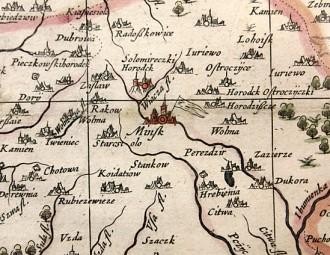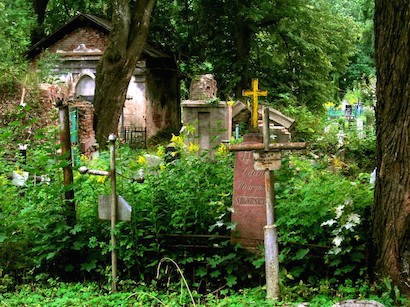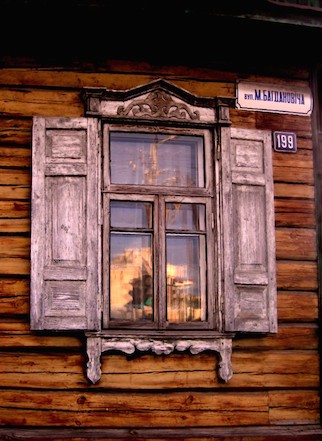A guide to unseen Belarus
 photo by EuroBelarus Information Service
photo by EuroBelarus Information Service
Minsk attracts more and more foreign visitors. Tourism clearly develops. The IHWC 2014 marked a big mile stone here, bringing numerous first time guests to Minsk, writes Thomas Bergmann.
Many guides provide a standard list of the city's attractions. But what discoveries await those willing to leave the main tourist trails?
We have already described an alternative view on tourism in Belarus. Now BelarusDigest prepared one more guide to the non-mainstream Minsk.
In search of an Old Town
World War II, but also post-war city planning left little of the old Minsk. This is the conventional wisdom about the Belarusian capital. A second glance will probably get you to Trayetskaye pradmestsye— the Trinity Suburb.
This neighbourhood along Svislach-river is where the settlement of Minsk started. Yet, the houses you find here today were all build in Soviet times. Similar attempts to construct an old town are made around Ploshcha Svabody with buildings like the Old Town Hall, build in 2003.
Not far away though you get a better sense of Mink's past. In streets like Rakauskaya or Revalutsyonaya many 19th century brick buildings have survived.
Sometimes old structures also hide behind post-war architecture like the Catholic Church of the Holy Trinity near the intersection of Nezaleszhnasci avenue and Masherova avenue.
When back in the city centre also make sure to stop by the Pobeda Cinema on Internatsyanalnaya street. Notable is not only its pink exterior but also the posters advertising the films currently in show. A closer look reveals that they are all hand-painted. If you are lucky you can even get in for free, as Pobeda hosts a number of film festivals throughout the year.
Meet the real Minchanin
The façades of Minsk's main boulevards seem quite impressive. But they can also be intimidating and impersonal. To meet the real Minsk, take a turn through the many plaster-decorated arches into the backyards of Minsk. Here you will find authentic Belarusian life and meet the real inhabitants of Minsk – also known as Minchanye.
Babushkas discussing the latest gossip or feeding cats. Children playing. And men enjoying an after-work beer. Lovers of old Soviet cars may spot an old Moskvich or Volga and with a bit of luck – even a Pobeda. Some of them have even retained their original Soviet-era white-on-black licence plate. Walking through the backyards will also allow you huge short-cuts as you can simply walk through a street block, instead of walking all the way to the next corner.
A trip to the 18th century
From the heart of Minsk it is only a short metro-ride on Autozavodskaya line to Pushkinskaya station. Walk along the main avenue – Prytytskyha street – until you reach the gates of Kalvarya cemetery. As one of the few places in Minsk to do so, this cemetery offers a trip back in time. Some of the graves have remained untouched for over 200 years. Quite remarkable given Minsk's trubled past in the 20th century.

Kalvarya Cementry. Photo by Thomas Bergmann.
The inscriptions on the tombstones – some in Cyrillic, many in Polish – also reveal Belarus' heritage at the crossroads of different cultures. Finding a national identity remains an issue in today's Belarus. Many of the graves deserve to be repaired. Time has clearly taken its toll and decay is all around. But that is exactly what makes the morbid atmosphere of this unique place.
Heading out the flea market
Minsk's flea market scene still has room to develop. What is considered vintage in the West is either still in use in Belarusian homes – and repaired until it completely falls apart – or thrown away, considered junk. Still, a visit to Zhdanovichi market is worth while.
A short and inexpensive eletrichka train ride gets you to Lyabyazhi station. Leave the babushkas on the train aside – they are heading out to the dacha. Just follow the crowd getting off at the station. The huge market spans over several acres and offers quite literally everything you may want to buy. Food, electronics, clothing and much more.
At the very end – after taking the underpass to cross Tsimirazyeva street – you find the flea market section. Soviet memorabilia, old tools, second hand clothing and every thing else vendors may want to make a few rubles with. The best time to hit the market is a Saturday morning with good weather. Bring sufficient cash and enough Russian to negotiate prices.
For those shopping for second hand books, the book store on the intersection of Marks and Engels street has a separate section for old books. A similar shop called Bookinist is located on praspekt Nezalezhnosti – just north of Akademiya navuk metro station.
The bunny in your wallet
Spending a few days in Belarus you may already have fallen in love with the Belarusian ruble, or rather: its many colourful bank notes. Today they take you on a trip to the most important sights and buildings of the country.
Back in the 1990s, Belarus also had its natural beauty on display on its currency. All Belarusians remember the one-ruble note with a bunny on its front side. It even earned the whole currency the nick name of zaichik – the Russian term for a small bunny.
The entrance hall of the BelSwiss Bank at Ploshcha Svabody features a collection of all Belarusian bank notes of the past 25 years. From the last Soviet ruble – bearing Lenin's profile – to the current series.
Minsk is a village
A ride down the main roads into town through areas like Kamenaya Horka creates the impression that most houses in Minsk are 20 stories high and have the shape of a box. But Minsk can also be quite the opposite. There are several parts of town with little old wooden houses that take you on a trip to a Belarusian village.

Village in Minsk. Photo by Thomas Bergmann.
Old water pumps in the yard, colourful houses, unpaved roads and blossoming gardens you find north of Kyivsky Skver, around Hrushauka metro station or on the upper section of Bahdanovicha street. And Minsk even still has cobblestone roads like the short strip near the intersection of Bahdanovicha and Amurskaya streets.
Make friends with Belarusians
Minsk and Belarus remain an extraordinary tourist destination. But be rest assured that even wandering out of the city centre is safe, as crime is generally low in Belarus.
Therefore go out and explore. And Belarusian are eager to meet foreigners. Platforms like couchsurfing will help you to make friends in Belarus. They will introduce you to the real secrets of their country.
-
03.01
-
07.10
-
22.09
-
17.08
-
12.08
-
30.09



























